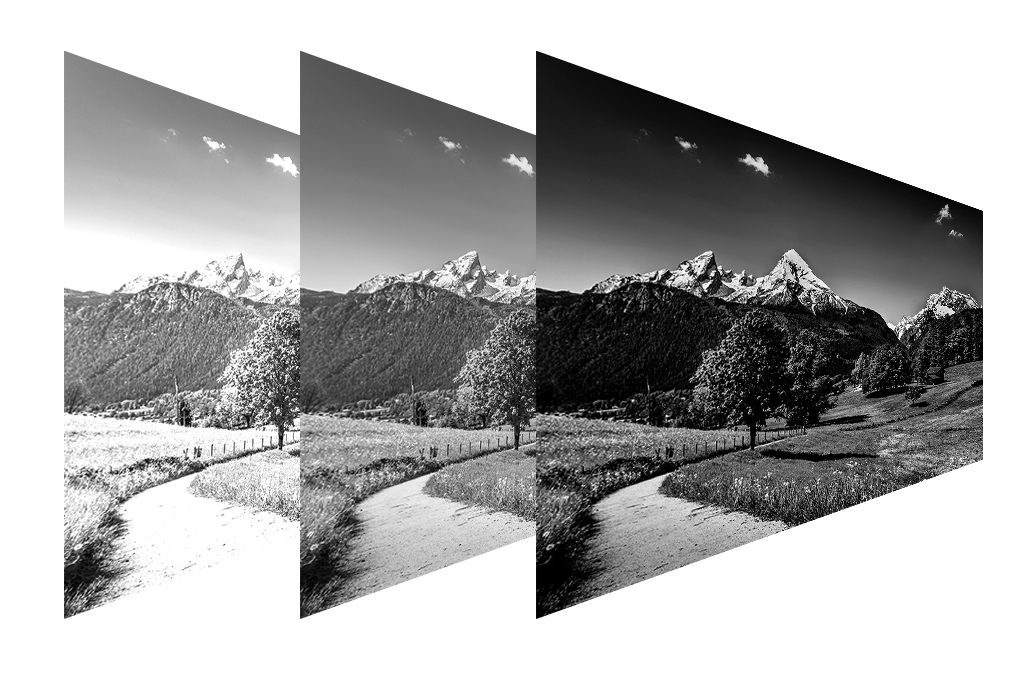 In our last blog about Ultra High Definition (UHD), we covered the spacial resolution of the human visual system, and how (horizontally) the highest frequency the average human with 20/20 vision can detect subtends an angle of approximately 1 arc minute (1/60th of a degree) at the retina.
In our last blog about Ultra High Definition (UHD), we covered the spacial resolution of the human visual system, and how (horizontally) the highest frequency the average human with 20/20 vision can detect subtends an angle of approximately 1 arc minute (1/60th of a degree) at the retina.
There’s another aspect we need to consider, though, and that’s the sensitivity of the eye to variations in brightness. The human eye can resolve the wide range of colors and brightness found in the natural world, but our existing TV systems limit the amount of light that the display can produce to the range of 0.117 nits (a nit is a measurement of brightness) to 100 nits for full white.
In comparison, the natural world can produce high brightness colors in excess of 1400 nits. So Cinematographers and Directors of Photography have to adjust aperture on their cameras to allow those bright colors to still fit within the available range of TV transmission. The same is true for the range of colors that can be reproduced (“color gamut”), which is again limited to what is referred to as “rec 709 colors”. This results in what is now termed “Standard Dynamic Range” (or SDR) images. It’s not perfect, but it’s the best we’ve had so far (and it was largely determined by the available CRT technology at the time the specs were written).
Technology advances, and we now have display technologies that can produce a significantly wider black-to-white range, along with being able to reproduce a much wider set of colors. The result of both of these is displays that are capable of producing images which are much more vivid and true-to-life (assuming they were shot with this display technology in mind, of course) – this is what is now referred to as “High Dynamic Range” (HDR) images.
The displays themselves are only part of the story, however. Cinematographers/DPs must now set up their cameras to capture a much wider dynamic range, and for the transmission and processing (not too much of a problem there!). The colorists need to work their magic in HDR color space (not too much of a problem there, either). But the processing equipment needs to be able to work on signals of 12 bits or larger, in order to process these images. Generally speaking, this means that these processing devices must have an internal video pipeline of 16 bits. If not, the resultant processing will “crush” the dynamic range of the image, which goes against the whole point of HDR – in the worst case, they may throw away bits, which will result in significant contouring.
But there’s a bigger problem than that: whilst you can already find TV sets which are labeled as being HDR capable, there are no standards as yet for the format to be used for delivery of HDR material – in fact, the CEA has only just announced the industry definition for HDR compatible displays themselves. We have to consider legacy support as part of the process– how should an SDR set display an HDR signal? There are several approaches, some of which separate the signal into SDR images with a sidecar transmission that provide the additional information needed to recreate the HDR signal in an HDR display. Others use metadata to tell the SDR set what to do with an HDR signal. HDR is unlikely to achieve widespread adoption until this standardization issue is resolved.
One thing that is certain, though, is that HDR is very much at the forefront of everybody’s mind when considering new television technologies. You only have to see the images produced by a properly sourced HDR display to understand the impact this technology is going to have on TV viewing. In fact, a well set-up 1080p HDR image will blow away an SDR 4K image in almost every respect – we just need to standardize on the delivery format and EOTF/PQ (the HDR equivalent of Gamma) so manufacturers know what to design to.
At Telestream, we are always watching developments such as this, to ensure our customers have access to all the latest technologies. Vantage was engineered with a 16 bit (award-winning) video processing system and pipeline, so is perfectly poised to process HDR material – in fact, for certain input/output configurations, we already can!
Want to learn more about HDR? Download our ebook, “The Truth and Hype on 4K, 8K, UHD and HDR”.

